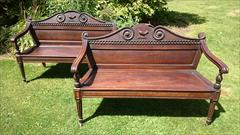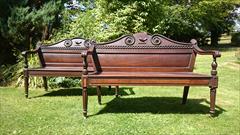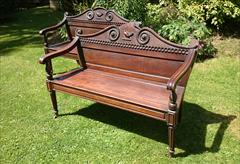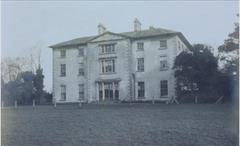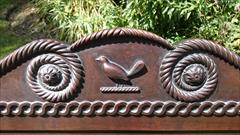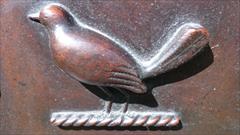Antique Benches & Window Seats
The Clogrennan Hall Seats
Very rare pair of antique Irish benches made of dense grained Cuban mahogany. They are very well drawn with waisted back and curved and tapering backs and back legs. The legs are turned and fluted and there are square panels above the leg and to the frieze that are reminiscent of designs by Gillow.
The seat and back are made of unusually large sections of this expensive cut of solid mahogany and the grain from the front can also be seen on the reverse side.
The rope twist is a more elaborate version of a decorative device that was very popular at the time as it recalled the naval successes of the era. The carving is very precise and the decoration extends almost the whole way across the back of the benches, terminating at either end and broken in the centre, with four tapering spirals per bench, each one enclosing a paterae of a stylised flower head.
The intricate horizontal guilloche decoration on the back is like the stylised decoration used to depict the sea as found in ancient Greek and Roman art, especially the the contemporaneous discoveries of Pompeii and Herculanium.
The Rochfort family seal can be seen in the centre of each bench, interestingly the robin is depicted facing the same way on both benches as is correct, and with the guilloche decoration being arranged in symmetrical manner, as used to be traditional in cabinetmakers carving.
Irish circa 1810-1815 £85,000
37 1/4" / 95cm high
52 1/4" / 133cm wide
22 1/2" / 57cm deep
Attributed:
Mack, Williams and Gibton, Dublin, Ireland
John Mack held a Royal Warrant for furniture making from 1807 and supplied furniture for the state apartments and other rooms at Dublin Castle as well as other important pieces ordered through the Government appointed Board of Works.
John Mack, Zachariah Williams and William Gibton officially joined forces in May of 1812.
Provenance:
This pair of benches were made for the Rochfort family of Clogrennan, County Carlow, Ireland.
They were made for Colonel John Staunton Rochfort (d. 1844) who was High Sheriff of County Carlow in 1823.
They were made at some point during the building of the new house which took from 1806 to 1815 to complete.
The house had fifty two rooms including thirty bedrooms, thirty three fireplaces, three hundred and sixty five panes of glass and cost £32,000 to build.
The son of John Staunton Rochfort, Horace William Noel Rochfort, JP, DL, (1809-1891) was, like other family members, involved with politics. He was High Sheriff of County Carlow and was made Queen's Council in 1845.
The Rochfort family had first arrived in Carlow when Robert Rochfort (1652-1727) bought three thousand acres from the Butler family for his second son John.
The Clogrennan branch of the Rochfort family are related to the Rochforts of Westmeath, the Earls of Belvedere.
The house was eventually sold by Horace Crosby Rochfort in 1922. The picture of the house is from 1922, it is now derelict and surrounded by farmland. It is not clear who owns the house now.
Horace returned to England and brought the seats back with him. The benches have been in the Rochfort family since they were made. For some of the 20th century they were held separately by different members of the family, but they have now been reunited to be kept as a pair as originally intended.
Clogrennan Castle which lies on the west bank of the River Barrow was built in the fifteenth century in order to defend a pass between the River Barrow and the extensive woodlands along the sides of the Killeshin Hills. It is believed to be in ruins since the eighteenth century and in the nineteenth century the derelict castle became a gateway to Clogrennan House, seat of the Rochfort family. The ruins bear little resemblance to the original castle and seem to incorporate stone from a nearby ancient church.
Clogrennan was formerly an estate owned by the Dukes of Ormonde of Kilkenny Castle. From the mid-seventeenth century the Rochforts, a distinguished family owned a 3,000 acre estate based around Clogrennan. Robert Rochfort was Speaker in the Irish House of Commons in 1695 and in 1707 he was appointed Chief Baron of the Exchequer. According to some sources Carlow hosted the first formal game of cricket ever to be played in Ireland with Horace William Rochfort having founded Carlow’s first cricket club in 1831. In 1873 he was also responsible for founding Carlow Polo Club.
Built in the early 19th century the now ruined home of the Rochfort family was described in 1825 as a “house of modern erection and is a plain building, respectable in character, and extremely commodious, but scarcely worthy of its situation on a demesne of such distinguished beauty”. All the materials for the building came from the area – limestone, granite, timber, marble and shale for roof. It was the building of the house that led to the financial ruin of the Rochfort’s. The house was noted for its large ballroom and hosting regular parties. The last ball was held in January 1922 just before the house was sold. It has been roofless since 1945.
This is what was written about the Estate in 1827 in the Gazetteer:
"The principal seats are Clogrennan Castle, the residence of Colonel Rochfort; Milford, of J. Alexander, Esq.; Fonthill, of W. Fishbourne, Esq.; and Lenham Lodge, of Captain Butler. Clogrennan was formerly an estate of the Dukes of Ormonde, and gave the title of baron in the Irish peerage to the Earls of Arran. The castle was taken by Sir Peter Carew, in 1568, from Sir E. Butler, who was then in rebellion: in 1642 it was besieged by the Irish, but was relieved by Col: Sir P. Wemys; and here the Marquess of Ormonde mustered his forces prior to the battle of Rathmines. The ruins, overgrown with ivy and forming a remarkably picturesque object, yet exist, together with the remains of an old church, near the present house, which is approached through one of its gateways. The grounds, which are very beautiful, are bordered on the west by the mountains of the Queen's county, the sides of which are clothed with wood to a considerable height, and on the east by the course of the Barrow, adorned by several well-wooded islets. On Bawn-Ree, James II. encamped after his defeat at the battle of the Boyne. Some curious relics of antiquity, including brazen swords and arrow-heads, were found in a ford across the Barrow, about 1 ¼ mile distant, in 1819."
Here is some more information showing the extent of the Rochfort's sphere of influence in the area:
The Rochfort family were established at Clogrenan, parish of Cloydagh, county Carlow, from the early 18th century. They acquired lands in the parish of Annaghdown, barony of Clare, county Galway, through the marriage in 1722 of John Rochfort and a daughter of Thomas Staunton, Member of Parliament. A sale rental dated 1856 of estates in counties Galway and Wexford shows that most of the county Galway lands were held in fee simple but some were held on a lease dated 9 April 1781 from John Skerrett to John Rochford. The county Galway estate included a townland in the parish of Ahascragh, barony of Killian, also recorded as the property of Col. Rochfort in the Ordnance Survey Field Name Books. The barony of Clare estate was bought by a branch of the Blake family. John Egan was agent for the Rochfort estate in the 1830s and held one of the townlands at the time of Griffith's Valuation.
Clogrennan has been an important centre for the quarrying of limestone for centuries. There are a number of limestone quarries located in this area of County Carlow and many buildings and monuments both in Carlow and further afield are made of limestone cut from these quarries. Lime is also used as an important fertiliser for the farming sector. Located close to here is Clogrennan Lime, a specialist chemical lime producer supplying products for use in agriculture and construction as well as the pharmaceutical and environmental sectors.


